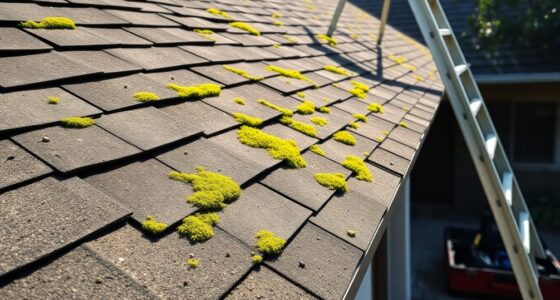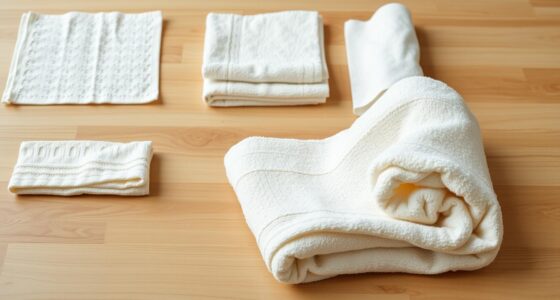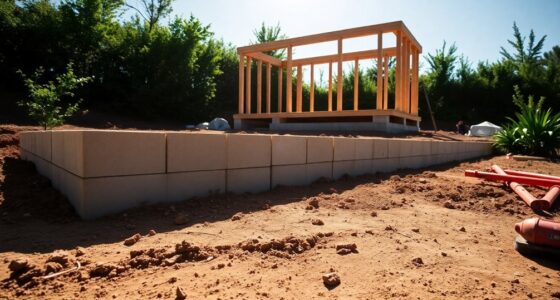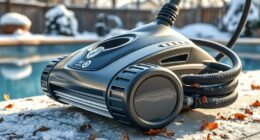To prevent suction loss in your pool cleaner, keep your skimmer and pump baskets clear of debris, check hose connections for leaks or obstructions, and make sure the cleaner is properly attached and positioned. Regularly inspect and replace worn parts, like hoses or gaskets, and control water flow with your pump’s valves. Maintaining a clean, leak-free system helps improve suction. Stay attentive to these details, and you’ll keep your cleaner running smoothly—more tips await if you continue.
Key Takeaways
- Regularly clean and clear skimmer, pump baskets, and filters to maintain proper water flow.
- Check hoses, fittings, and seals for cracks, leaks, and obstructions; tighten or replace as needed.
- Ensure hose connections are secure, free of kinks, and properly fitted to prevent air leaks.
- Maintain the pool cleaner’s brushes, wheels, and intake vents; replace worn parts promptly.
- Adjust water flow settings and pressure using gauges and valves to optimize suction and prevent loss.
Check and Clear the Skimmer and Pump Baskets
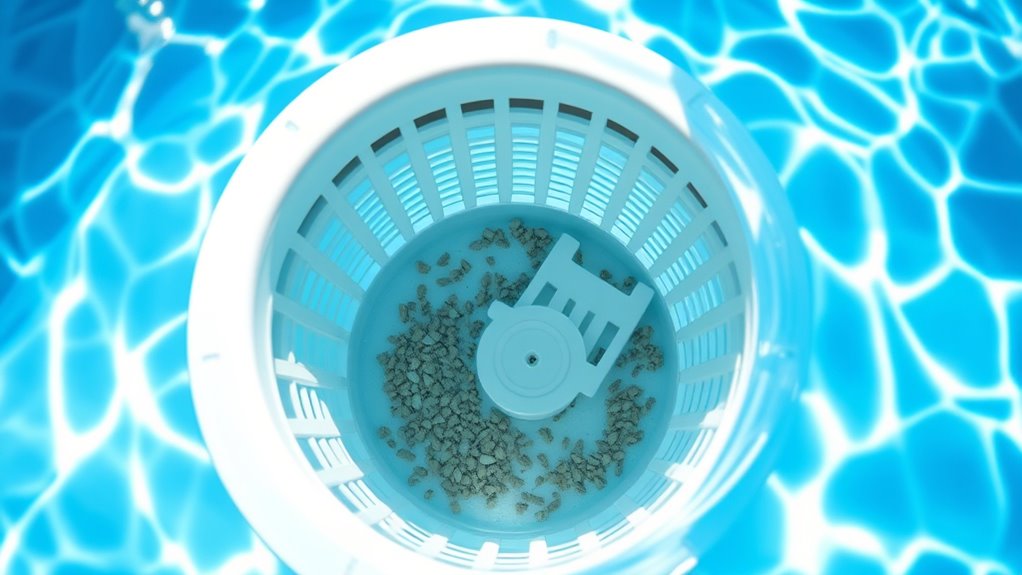
To prevent suction loss, you should regularly check and clear the skimmer and pump baskets. Start by removing the skimmer basket and inspecting it for debris like leaves, insects, or twigs. If it’s clogged, water flow to your pool cleaner drops, causing suction issues. Next, check the pump basket; remove it and clear out any debris that’s accumulated. A clogged pump basket reduces water flow and puts strain on your pump. Make it a routine to clean both baskets at least once a week, especially during heavy pool use or windy days. Keeping these baskets free of debris ensures ideal water flow, preventing suction loss and helping your pool cleaner work efficiently. Regular maintenance of these components is key to a trouble-free swimming experience. Additionally, ensuring your pool filtration system is functioning properly can further help prevent suction problems. Properly maintaining water flow by keeping baskets clean supports the overall efficiency of your pool equipment, reducing the risk of suction loss and potential damage. Incorporating routine inspections can help identify issues early and maintain optimal water circulation. Moreover, understanding the importance of system balance ensures your pool operates smoothly and efficiently over time.
Inspect and Maintain Proper Hose Connections

Ensuring your pool cleaner’s hose connections are secure is essential for maintaining proper suction. Check all hose connections regularly, making sure they are tight and properly fitted. Loose or damaged fittings can cause air leaks, leading to suction loss. Inspect the hose connections for cracks, wear, or corrosion, replacing any damaged parts immediately. Use proper fittings designed for your pool cleaner model to guarantee a snug fit and prevent leaks. Properly secured hose connections maintain ideal water flow, improving cleaning efficiency and preventing suction loss. Regular inspection and maintenance of these connections help keep your pool cleaner functioning smoothly and extend its lifespan. Additionally, understanding the role of AI in healthcare highlights the importance of innovative solutions in maintaining equipment and improving overall efficiency. Staying informed about technological advancements can also aid in troubleshooting and optimizing your pool cleaning system. Maintaining good hygiene practices around your equipment can further reduce the risk of malfunctions and prolong its service life, while proper maintenance routines support ongoing performance.
Ensure the Pool Cleaner Is Correctly Attached and Positioned

Properly attaching and positioning your pool cleaner is crucial for peak performance. Correct attachment ensures the cleaner moves smoothly and maintains strong suction. To achieve this, check that the hose connections are secure and free of leaks. Confirm the cleaner is aligned properly on the pool surface. Ensure the intake vents are unobstructed and the brushes contact the pool floor. Adjust the positioning of the cleaner to avoid obstacles or uneven surfaces. Regularly verify that the cleaner’s weight is balanced to prevent it from floating or getting stuck. Remember:
- Secure all hose fittings tightly
- Position the cleaner on a flat, stable surface
- Check for and remove any debris from intakes
- Keep the cleaner level and centered
- Adjust for pool surface irregularities
Proper attachment and correct positioning help prevent suction loss effectively. Additionally, inspecting and maintaining the suction system regularly ensures consistent performance and longevity of your pool cleaner. Regularly checking hose connections for wear and tear can prevent unexpected disconnections and improve overall efficiency. Incorporating proper installation standards and ensuring consistent maintenance practices can also minimize potential issues related to suction loss over time.
Regularly Clean and Maintain the Pool Cleaner Itself
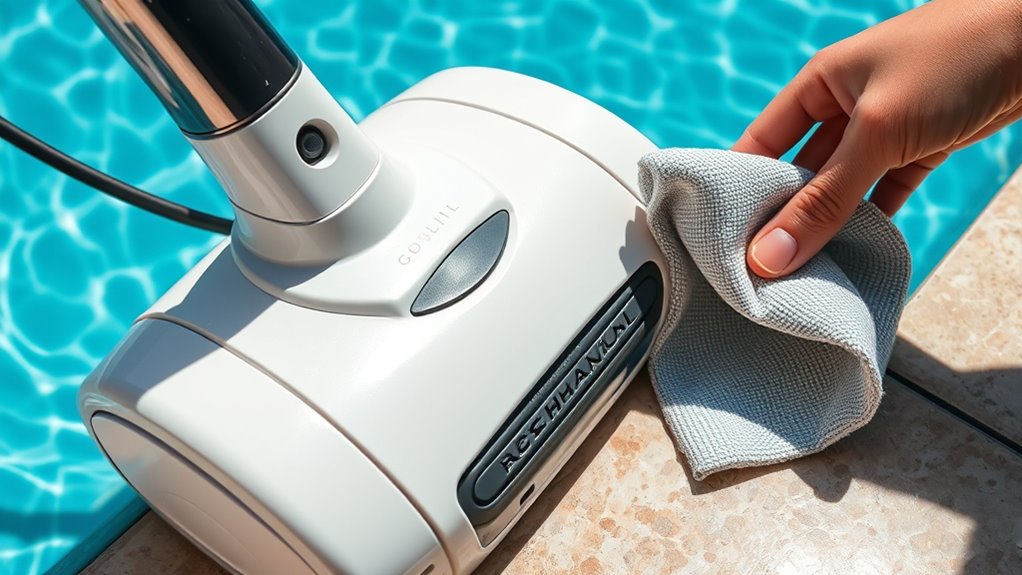
You should regularly inspect your pool cleaner for debris that can clog its parts or reduce suction. Worn or damaged components, like hoses or brushes, need replacement to keep the cleaner functioning properly. Keeping your cleaner clean and in good shape helps prevent suction loss and guarantees it works efficiently.
Inspect for Debris
Have you checked your pool cleaner for debris lately? Regularly inspecting it helps prevent debris buildup and surface obstructions that can cause suction loss. Clear out any leaves, dirt, or debris trapped in the brushes, hoses, or filters. Look for blockages in the intake or jets, ensuring water flows freely. Check the brushes and wheels for tangled hair or debris that could impede movement. Also, examine the skimmer and pump baskets to remove any accumulated debris, maintaining peak suction. Additionally, inspect the hose for cracks or obstructions. Keeping your cleaner free of debris and surface obstructions ensures it operates efficiently, reducing the risk of suction loss and helping your pool stay clean and well-maintained. Regular maintenance of your headphones can also help prevent issues that affect your pool cleaner’s performance. Being aware of environmental impacts related to pool equipment can guide you toward more sustainable maintenance practices. Understanding how pool equipment interacts with your environment can help you choose eco-friendly cleaning and maintenance options. Monitoring sustainable practices can further improve the longevity and efficiency of your pool equipment. Incorporating routine inspections into your maintenance schedule ensures ongoing optimal performance.
Replace Worn Parts
Regularly cleaning and maintaining your pool cleaner is essential to prevent worn parts from causing suction loss. Over time, parts like replacement valves and worn gaskets can deteriorate, reducing efficiency. Inspect these components frequently and replace any that show signs of wear or damage. Worn gaskets may develop cracks or leaks, compromising the suction seal, while faulty replacement valves can restrict water flow. Keeping these parts in good condition ensures your cleaner operates at peak performance and maintains strong suction. Always follow the manufacturer’s instructions when replacing parts, and use quality replacements to avoid recurring issues. Regular maintenance not only prevents suction loss but also extends the lifespan of your pool cleaner, saving you time and money in the long run. Incorporating proper maintenance practices can further optimize your cleaner’s performance and prevent issues before they arise. Additionally, understanding auditory feedback therapy principles can help inform maintenance routines that include timely inspections and adjustments.
Monitor and Adjust Water Flow Rate and Pressure
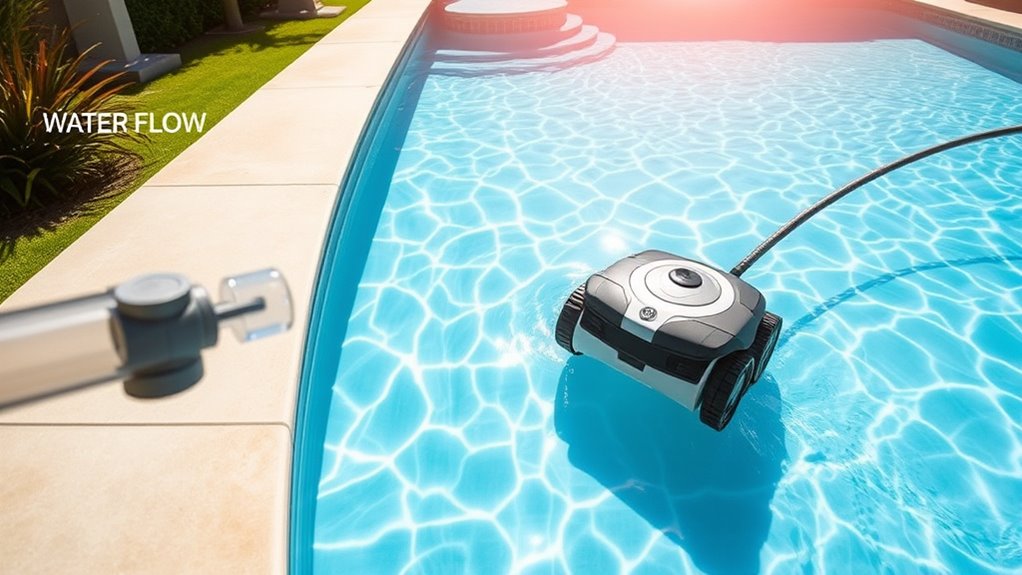
Monitoring and adjusting the water flow rate and pressure is essential to prevent suction loss in your pool cleaner. If the water flow is too low, the cleaner won’t move properly; if it’s too high, it can cause leaks or damage. Proper pressure regulation guarantees steady suction and efficient cleaning. To get it right:
Monitoring and adjusting water flow and pressure ensures effective pool cleaning and prevents damage.
- Check your pool cleaner’s manual for ideal water flow settings
- Adjust the skimmer or pump valve to control flow
- Ensure hoses are free of kinks and obstructions
- Regularly clean or replace filters to maintain proper pressure
- Use a pressure gauge to monitor and fine-tune pressure levels
- Regular maintenance and system tuning can optimize your system’s performance and prevent issues related to inconsistent water flow. Additionally, inspecting water flow regulation components regularly helps maintain consistent suction and prolongs equipment lifespan. Ensuring that all pressure components are functioning correctly can further prevent fluctuations that lead to suction loss, and keeping an eye on system performance ensures your pool stays clean and efficient.
Eliminate Leaks and Obstructions in the Pool System

To prevent suction loss, start by checking for cracks or gaps in your pool system that could cause leaks. Make sure to clear any obstructions regularly so water can flow smoothly. Also, inspect the sealant around fittings to verify it’s intact and isn’t allowing air or water to escape. Incorporating data-driven strategies can help you identify patterns of leaks or blockages, enabling more targeted maintenance.
Check for Cracks and Gaps
Cracks and gaps in your pool cleaner’s hoses, seals, or fittings can cause leaks that lead to suction loss. To prevent this, perform regular crack detection and inspect all connection points. Look closely for any visible damage or deterioration that might compromise the system. If you find cracks, replace or repair the damaged parts promptly. For gaps or loose fittings, use appropriate gap sealing techniques to restore a tight seal.
- Check hoses for visible cracks or tears
- Tighten loose fittings securely
- Replace worn-out seals or gaskets
- Seal small gaps with waterproof tape or sealant
- Inspect fittings for signs of deterioration
Clear Obstructions Regularly
Regularly clearing obstructions from your pool cleaner’s system is essential to maintain proper suction and prevent leaks. Check the hoses for kinks or blockages that can reduce flow, as hose flexibility is key to keeping a tight seal. Make sure the hoses are properly connected and free of twists. Additionally, perform regular filter maintenance—clean or replace filters to prevent debris buildup that can hinder water flow. Obstructions like leaves or dirt can cause suction loss, so inspect the cleaner’s intake and filter area frequently. Removing these blockages ensures maximum water flow and reduces strain on the system. Taking these simple steps helps your pool cleaner operate efficiently, prevents leaks, and keeps your pool sparkling clean.
Inspect Sealant Integrity
Inspecting the sealant around your pool cleaner’s connections is crucial for preventing leaks and maintaining ideal suction. Over time, sealant durability can diminish, leading to leaks that reduce efficiency. Regular leak detection helps catch issues early, saving you time and money. To guarantee proper sealant integrity:
- Check for cracks or gaps in the sealant
- Reapply or replace worn sealant promptly
- Tighten connections to prevent movement
- Clean surfaces before resealing
- Test for leaks after maintenance
Use Proper Accessories and Upgrades to Enhance Suction Power

Using the right accessories and upgrades can substantially boost your pool cleaner’s suction power. Upgrading hoses to thicker, more durable materials reduces leaks and improves water flow, ensuring better suction. Additionally, using booster pumps can provide extra pressure, especially for larger pools or stubborn debris. Installing a booster pump increases water flow directly to your cleaner, reducing suction loss and enhancing cleaning efficiency. Make sure hoses fit securely and are free of kinks to maintain ideal pressure. These upgrades prevent loss of suction caused by inadequate equipment or poor connections. By investing in proper accessories like upgraded hoses and booster pumps, you maximize your cleaner’s performance, keep debris from escaping, and enjoy a cleaner pool with minimal hassle.
Frequently Asked Questions
How Can I Tell if My Pool Cleaner Is Losing Suction?
You can tell if your pool cleaner is losing suction by noticing a drop in vacuum pressure during operation. If it moves sluggishly or stops cleaning altogether, debris blockage might be the culprit. Check the hose and intake for dirt or obstructions, as these can reduce suction. A noticeable decrease in power or uneven cleaning indicates your cleaner isn’t maintaining proper vacuum pressure, signaling you need to inspect for blockages.
What Signs Indicate Hose Damage Affecting Suction?
You’ll notice hose damage affecting suction if the cleaner struggles to move or leaves debris behind. Check for signs of hose integrity issues like cracks, holes, or leaks, which can cause seal leaks and reduce suction power. Also, inspect the hose connections for looseness or wear. Maintaining a good seal and replacing damaged sections promptly guarantees your pool cleaner operates efficiently and maintains strong suction.
How Often Should I Replace Worn-Out Pool Cleaner Parts?
For ideal pool cleaner performance, you should replace worn-out parts during regular pool cleaner maintenance, typically every 6 to 12 months or as needed. Keep an eye on your suction system troubleshooting; if your cleaner loses suction or struggles to move, it’s a sign to inspect and replace damaged components. Regularly updating parts ensures efficient cleaning and prevents issues that could lead to suction loss.
Can Weather Changes Impact Suction Performance?
Weather fluctuations and seasonal effects definitely impact your pool cleaner’s suction performance. Cooler temperatures, rain, or wind can alter water flow and create debris buildup, reducing suction efficiency. High humidity might also affect seals and hoses. To keep your cleaner working smoothly, regularly check and clean filters, hoses, and seals, especially during seasonal changes. Being proactive helps maintain strong suction despite changing weather conditions.
Are There Specific Brands Better at Maintaining Consistent Suction?
Think of your pool cleaner’s suction as a delicate dance—it needs the right partner to stay in sync. When you compare brands, some like Dolphin and Hayward stand out for maintaining steady suction. Regular maintenance tips, like checking hoses and filters, help keep performance consistent. Doing your research and selecting a trusted brand guarantees your cleaner doesn’t miss a beat, keeping your pool sparkling effortlessly.
Conclusion
By paying close attention to your pool’s system and making small adjustments, you can keep the flow smooth and steady. Think of it as gently guiding a sailboat through calm waters—your pool cleaner will glide effortlessly, maintaining its dance beneath the surface. With regular care and a keen eye, you’ll guarantee the current stays just right, helping your cleaner do its job seamlessly and keep your pool sparkling all season long.


